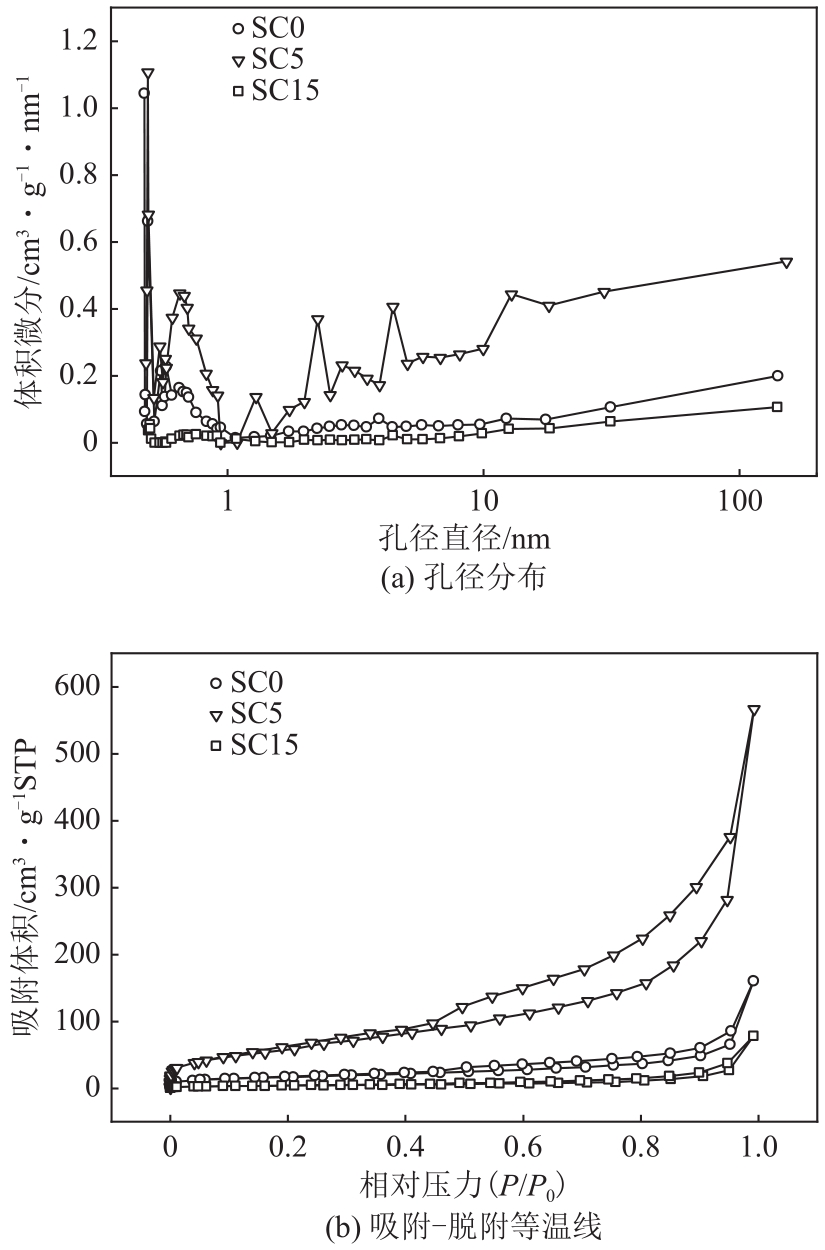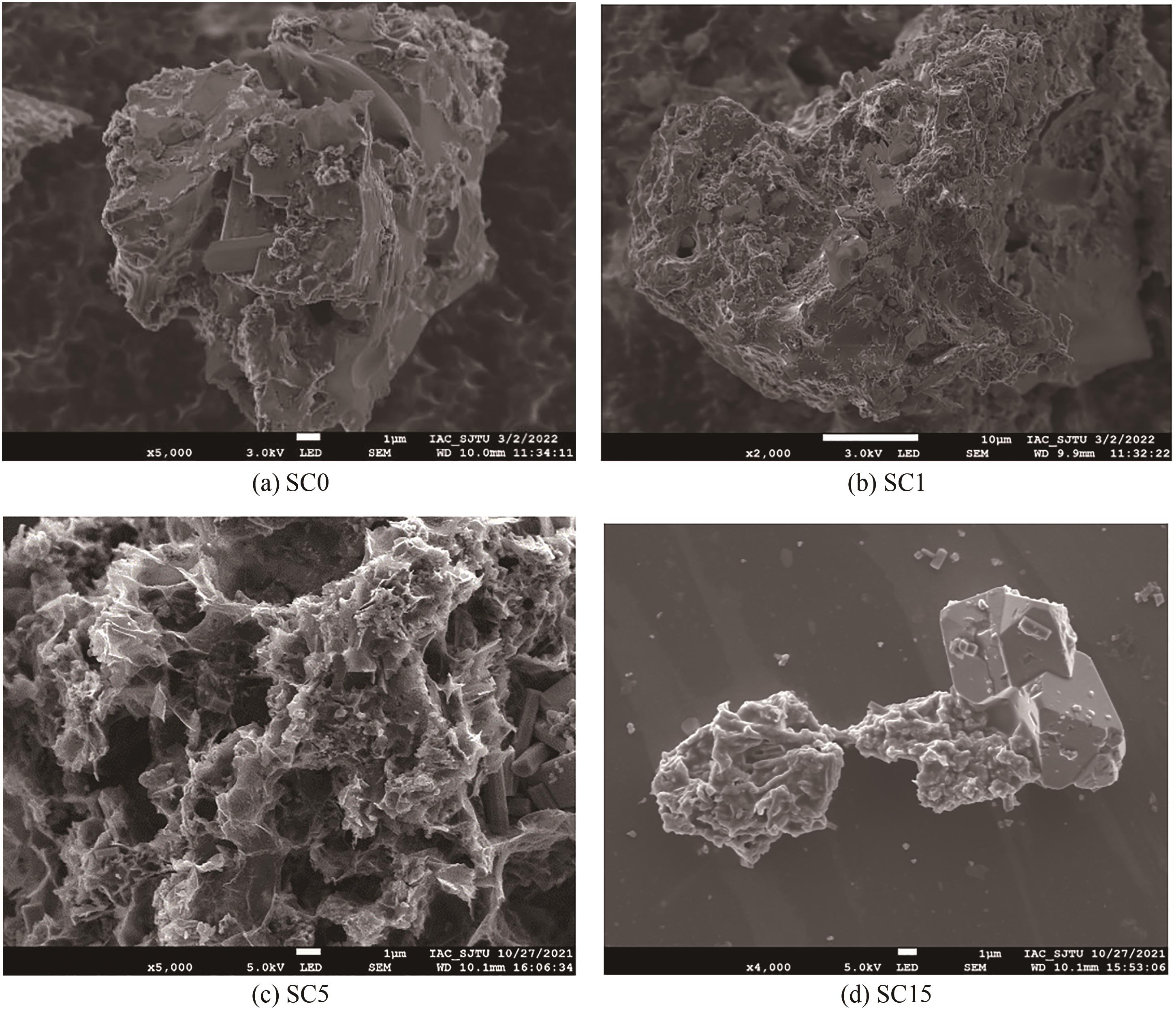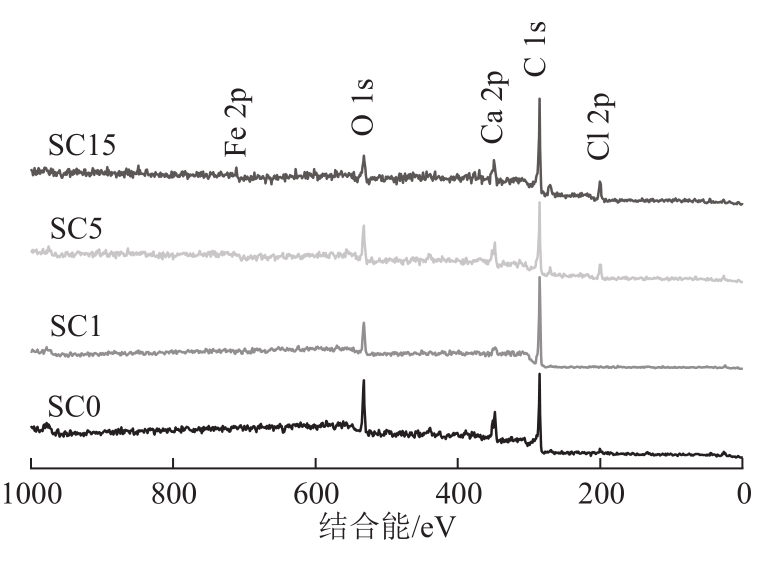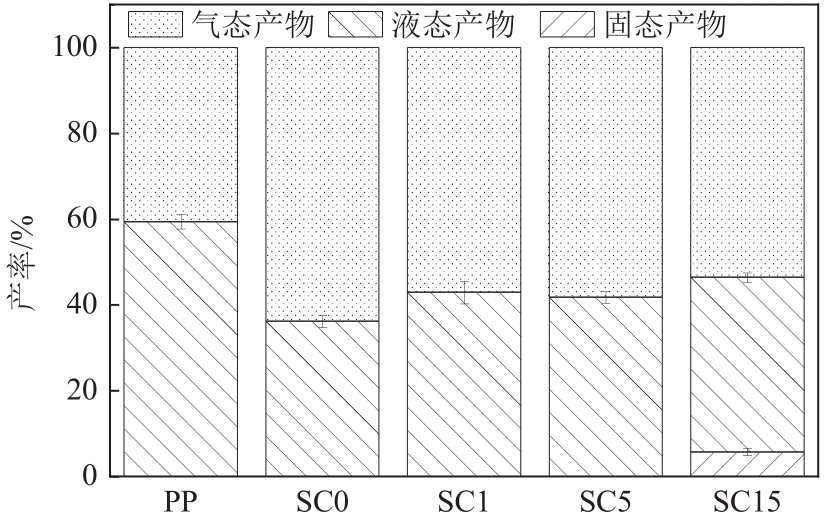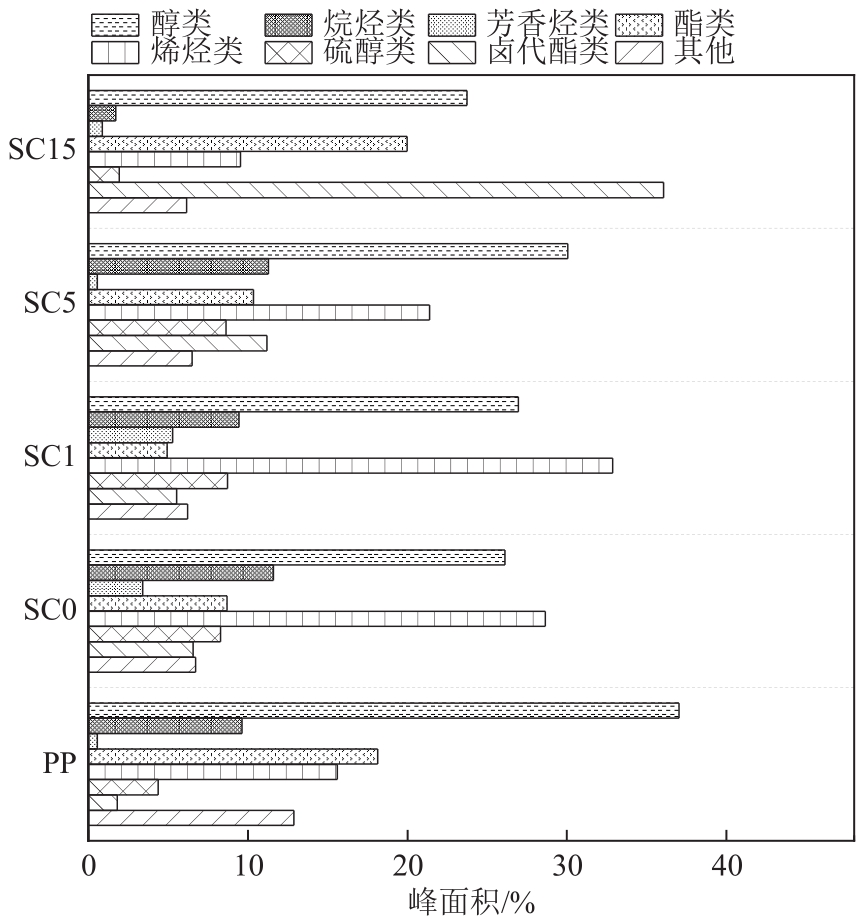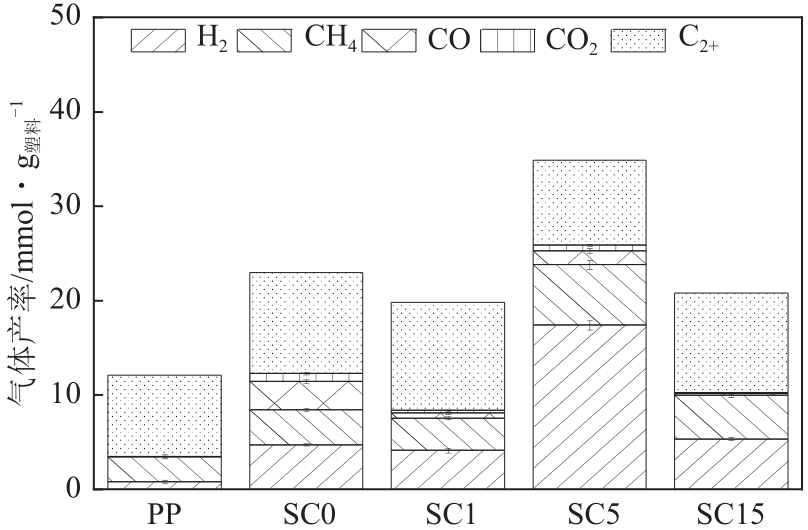化工进展 ›› 2023, Vol. 42 ›› Issue (2): 631-640.DOI: 10.16085/j.issn.1000-6613.2022-1352
• 专栏:工业污泥/精馏釜残的热化学转化利用 • 上一篇 下一篇
Fe负载污泥生物炭催化热解聚丙烯及产物特性
- 1.上海交通大学中英国际低碳学院,上海 201306
2.上海交通大学环境科学与工程学院,上海 200240
-
收稿日期:2022-07-19修回日期:2022-11-07出版日期:2023-02-25发布日期:2023-03-13 -
通讯作者:张景新 -
作者简介:胡兆岩(1998—),男,硕士研究生,研究方向为有机废弃物资源化利用。E-mail:444081248@qq.com。 -
基金资助:国家自然科学基金国际(地区)合作与交流项目(72061127004)
Catalytic pyrolysis of polypropylene plastics and product properties with Fe-loaded sludge biochar
HU Zhaoyan1( ), ZHANG Jingxin1(
), ZHANG Jingxin1( ), HE Yiliang1,2
), HE Yiliang1,2
- 1.China-UK Low Carbon College, Shanghai Jiao Tong University, Shanghai 201306, China
2.School of Environmental Science and Engineering, Shanghai Jiao Tong University, Shanghai 200240, China
-
Received:2022-07-19Revised:2022-11-07Online:2023-02-25Published:2023-03-13 -
Contact:ZHANG Jingxin
摘要:
针对塑料成分复杂、热解产油组分不稳定和品质控制难的问题,本文以市政污泥为原料制备Fe负载污泥基生物炭催化剂,以聚丙烯塑料(PP)催化热解促进焦油裂解与合成气生产的试验路线开展研究,分析了PP热解产物中焦油的去除效果、富H2合成气关键组分以及催化热解过程对污泥基生物炭表面特性的影响。结果显示FeCl3浸渍比为5%(质量分数,以Fe计)制备的污泥基生物炭可显著促进PP催化热解产氢,1g塑料氢气产率达17.39mmol,分别高于未经Fe负载污泥生物炭催化对照组268.43%以及纯PP热解对照组2046.91%。催化热解过程强化了焦油裂解,焦油裂解率达29.65%。焦油组分中醇类物质相对占比下降,烯烃类与卤代酯类物质相对占比上升。同时,催化热解后污泥基生物炭表面出现特殊的薄层状孔隙结构,比表面积增至225.90m2/g。XPS分析发现污泥基生物炭表面的碳氧官能团结合碳、晶格氧以及羧基氧相对比例上升,证明在此Fe浸渍比例下出现了更多的活性位点。
中图分类号:
引用本文
胡兆岩, 张景新, 何义亮. Fe负载污泥生物炭催化热解聚丙烯及产物特性[J]. 化工进展, 2023, 42(2): 631-640.
HU Zhaoyan, ZHANG Jingxin, HE Yiliang. Catalytic pyrolysis of polypropylene plastics and product properties with Fe-loaded sludge biochar[J]. Chemical Industry and Engineering Progress, 2023, 42(2): 631-640.
| 材料 | 成炭率 /% | 理论载Fe率 /% | 实际载Fe率 /% | Fe负载效率 /% |
|---|---|---|---|---|
| SC0(fresh) | 37.41 | 3.45 | 2.99 | 86.67 |
| SC1(fresh) | 39.40 | 5.54 | 4.92 | 88.81 |
| SC5(fresh) | 41.09 | 12.80 | 12.60 | 98.44 |
| SC15(fresh) | 48.23 | 20.60 | 19.22 | 93.30 |
表1 SC催化剂Fe负载效率
| 材料 | 成炭率 /% | 理论载Fe率 /% | 实际载Fe率 /% | Fe负载效率 /% |
|---|---|---|---|---|
| SC0(fresh) | 37.41 | 3.45 | 2.99 | 86.67 |
| SC1(fresh) | 39.40 | 5.54 | 4.92 | 88.81 |
| SC5(fresh) | 41.09 | 12.80 | 12.60 | 98.44 |
| SC15(fresh) | 48.23 | 20.60 | 19.22 | 93.30 |
| 材料 | 比表面积 /m2·g-1 | 总孔体积 /cm3·g-1 | 平均孔径 /nm |
|---|---|---|---|
| SC0(fresh) | 40.692 | 0.1840 | 18.0843 |
| SC0 | 58.910 | 0.2476 | 16.8089 |
| SC1 | 55.245 | 0.2269 | 16.4317 |
| SC5 | 225.908 | 0.8773 | 15.5338 |
| SC15 | 14.536 | 0.1204 | 33.1333 |
表2 SC催化剂比表面积与孔径分布
| 材料 | 比表面积 /m2·g-1 | 总孔体积 /cm3·g-1 | 平均孔径 /nm |
|---|---|---|---|
| SC0(fresh) | 40.692 | 0.1840 | 18.0843 |
| SC0 | 58.910 | 0.2476 | 16.8089 |
| SC1 | 55.245 | 0.2269 | 16.4317 |
| SC5 | 225.908 | 0.8773 | 15.5338 |
| SC15 | 14.536 | 0.1204 | 33.1333 |
| 1 | 马占峰, 姜宛君. 中国塑料加工工业(2020)[J]. 中国塑料, 2021, 35(5): 119-125. |
| MA Zhanfeng, JIANG Wanjun. China plastics industry(2020)[J]. China Plastics, 2021, 35(5): 119-125. | |
| 2 | 谭捷. 聚丙烯(PP).中国化学工业年鉴.[M]. 北京: 中国化工信息中心, 2019: 259-262. |
| TAN Jie. Polypropylene(PP). China chemical industry yearbook[M]. Beijing: China Chemical Information Center, 2019, 259-262. | |
| 3 | 李明丰, 蔡志强, 邹亮, 等. 中国石化废旧塑料化学回收与化学循环技术探索[J]. 中国塑料, 2021, 35(8): 64-76. |
| LI Mingfeng, CAI Zhiqiang, ZOU Liang, et al. Exploration on chemical recovery technology of plastic wastes in Sinopec[J]. China Plastics, 2021, 35(8): 64-76. | |
| 4 | 王金星. 塑料垃圾化学链燃烧控制二𫫇英排放的研究[D]. 武汉: 华中科技大学, 2016. |
| WANG Jinxing. Study on chemical looping combustion of plastic wastes for controlling the emission of PCDD/fs[D]. Wuhan: Huazhong University of Science and Technology, 2016. | |
| 5 | 延雨宸,杨忠芳,余涛.土壤中微塑料的来源、生态环境危害及治理技术[J]. 中国地质, 2022, 49(3): 770-788. |
| YAN Yuchen, YANG Zhongfang, YU Tao. Sources, ecological hazards and treatment technologies of microplastics in soil[J]. Geology in China, 2022, 49(3): 770-788. | |
| 6 | 俞东辉. 废旧塑料热裂解技术的研究[D]. 上海: 华东理工大学, 2012. |
| YU Donghui. Research on pyrolysis of waste plastics recycling technology[D]. Shanghai: East China University of Science and Technology, 2012. | |
| 7 | Sumin PYO, KIM Young Min, PARK Youna, et al. Catalytic pyrolysis of polypropylene over Ga loaded HZSM-5[J]. Journal of Industrial and Engineering Chemistry, 2021, 103: 136-141. |
| 8 | 孙锴. 废塑料催化热解制备芳香烃的研究[D]. 杭州: 浙江大学, 2021. |
| SUN Kai. Study on aromatics production from catalytic pyrolysis of waste plastics[D]. Hangzhou: Zhejiang University, 2021. | |
| 9 | SHEN Yafei. Chars as carbonaceous adsorbents/catalysts for tar elimination during biomass pyrolysis or gasification[J]. Renewable and Sustainable Energy Reviews, 2015, 43: 281-295. |
| 10 | QI Pengyu, CHANG Guozhang, WANG Hongchao, et al. Production of aromatic hydrocarbons by catalytic co-pyrolysis of microalgae and polypropylene using HZSM-5[J]. Journal of Analytical and Applied Pyrolysis, 2018, 136: 178-185. |
| 11 | YAO Dingding, LI He, DAI Yanjun, et al. Impact of temperature on the activity of Fe-Ni catalysts for pyrolysis and decomposition processing of plastic waste[J]. Chemical Engineering Journal, 2021, 408:127268. |
| 12 | Abu EL-RUB Z, BRAMER E A, BREM G. Experimental comparison of biomass chars with other catalysts for tar reduction[J]. Fuel, 2008, 87(10/11): 2243-2252. |
| 13 | WANG Chenxi, LEI Hanwu, KONG Xiao, et al. Catalytic upcycling of waste plastics over nanocellulose derived biochar catalyst for the coupling harvest of hydrogen and liquid fuels[J]. Science of the Total Environment, 2021, 779: 146463. |
| 14 | 胡子健. 中国城市建设统计年鉴[M]. 北京: 中国统计出版社, 2021: 509-511. |
| HU Zijian. China urban construction statistical yearbook[M]. Beijing: China Statistics Press, 2021: 509-511. | |
| 15 | 王琳, 李德彬, 刘子为, 等. 污泥处理处置路径碳排放分析[J]. 中国环境科学, 2022, 42(5): 2404-2412. |
| WANG Lin, LI Debin, LIU Ziwei, et al. Analysis on carbon emission from sludge treatment and disposal[J]. China Environmental Science, 2022, 42(5): 2404-2412. | |
| 16 | CHEN Yidi, WANG Rupeng, DUAN Xiaoguang, et al. Production, properties, and catalytic applications of sludge derived biochar for environmental remediation[J]. Water Research, 2020, 187: 116390. |
| 17 | LIANG Jun, XU Xiaoyun, ZHONG Qijun, et al. Roles of the mineral constituents in sludge-derived biochar in persulfate activation for phenol degradation[J]. Journal of Hazardous Materials, 2020, 398: 122861. |
| 18 | 陆鹏. 废弃物衍生炭基催化剂催化脱除气化焦油的研究[D].杭州: 浙江大学, 2019. |
| LU Peng. Study on catalytic removal of gasification tar by waste derived char catalyst[D]. Hangzhou: Zhejiang University, 2019. | |
| 19 | 姚丁丁. 废塑料催化热解制备富氢气体和碳纳米管的实验研究[D]. 武汉:华中科技大学, 2018. |
| YAO Dingding. Hydrogen rich syngas and carbon nanotubes production from pyrolysis-catalysis of waste plastics[D]. Wuhan: Huazhong University of Science and Technology, 2018. | |
| 20 | 徐永亮. 市政污泥基础特性及低温负压干化技术研究[D]. 镇江: 江苏大学, 2020. |
| XU Yongliang. Municipal sludge basic characteristics and negative pressure in low temperature drying technology research[D]. Zhenjiang: Jiangsu University, 2020. | |
| 21 | 方帅. 地下水厂铁泥制备磁性吸附剂的研究[D].长春: 东北师范大学, 2015. |
| FANG Shuai. Synthesis of magnetic absorbent with iron sludge from groundwater plant[D]. Changchun: Northeast Normal University, 2015. | |
| 22 | SUN Kai, HUANG Qunxing, Mujahid ALI, et al. Producing aromatic-enriched oil from mixed plastics using activated biochar as catalyst[J]. Energy & Fuels, 2018, 32(4) : 5471-5479. |
| 23 | 邹意义, 袁怡, 沈涛, 等. FeCl3改性污泥生物炭对水中吡虫啉的吸附性能研究[J]. 环境科学学报, 2021, 41(9): 3478-3486. |
| ZOU Yiyi, YUAN Yi, SHEN Tao, et al. Study on the adsorptive performance of imidacloprid from aqueous solution by FeCl3 modified biochar derived from sludge[J]. Acta Scientiae Circumstantiae, 2021, 41(9): 3478-3486. | |
| 24 | 王烽圣, 许晓毅, 时和敏, 等. Fe2+改性菖蒲生物炭制备及对水中磷的吸附特性[J]. 环境工程学报, 2021, 15(11): 3493-3503. |
| WANG Fengsheng, XU Xiaoyi, SHI Hemin, et al. Preparation of Fe2+ modified calamus biochar and its adsorption characteristics towards phosphorus from aqueous solutions[J]. Chinese Journal of Environmental Engineering, 2021, 15(11): 3493-3503. | |
| 25 | KEILUWEIT Marco, NICO Peter S, JOHNSON Mark G, et al. Dynamic molecular structure of plant biomass-derived black carbon (biochar)[J]. Environmental Science & Technology, 2010, 44(4): 1247-1253. |
| 26 | KIM Young Inn, HATFIELD William E. Electrical, magnetic and spectroscopic properties of tetrathiafulvalene charge transfer compounds with iron, ruthenium, rhodium and iridium halides[J]. Inorganica Chimica Acta, 1991, 188(1):15-24. |
| 27 | HAWN David D, DEKOVEN Benjamin M. Deconvolution as a correction for photoelectron inelastic energy losses in the core level XPS spectra of iron oxides[J]. Surface and Interface Analysis, 1987, 10(2/3): 63-74. |
| 28 | TERZYK Artur P. The influence of activated carbon surface chemical composition on the adsorption of acetaminophen (paracetamol) in vitro: Part Ⅱ. TG, FTIR, and XPS analysis of carbons and the temperature dependence of adsorption kinetics at the neutral pH[J]. Colloids and Surfaces A: Physicochemical and Engineering Aspects, 2001, 177(1): 23-45. |
| 29 | 柏珊珊. 铁改性稻壳生物炭对水中SMT的吸附效能及作用机制[D]. 哈尔滨: 哈尔滨工业大学, 2021. |
| BAI Shanshan. Adsorption efficiency and mechanism of iron-modified rice husk biochar for SMT in water[D]. Harbin: Harbin Institute of Technology, 2021. | |
| 30 | GONG Jiang, LIU Jie, WAN Dong, et al. Catalytic carbonization of polypropylene by the combined catalysis of activated carbon with Ni2O3 into carbon nanotubes and its mechanism[J]. Applied Catalysis A: General, 2012, 449: 112-120. |
| 31 | MOLINER R, SUELVES I, LÁZARO M J, et al. Thermocatalytic decomposition of methane over activated carbons: Influence of textural properties and surface chemistry[J]. International Journal of Hydrogen Energy, 2005, 30(3): 293-300. |
| 32 | ZHANG Li, YAO Zonglu, ZHAO Lixin, et al. Synthesis and characterization of different activated biochar catalysts for removal of biomass pyrolysis tar[J]. Energy, 2021, 232: 120927. |
| 33 | 庞赟佶, 刘心明, 陈义胜, 等. 生物炭负载Ca和Fe催化玉米秸秆热解挥发分重整提高产气率[J]. 农业工程学报, 2019, 35(3): 211-217. |
| PANG Yunji, LIU Xinming, CHEN Yisheng, et al. Catalytic reforming of volatiles in pyrolysis by using biomass carbon particle loading Ca and Fe and improving biogas yield[J]. Transactions of the Chinese Society of Agricultural Engineering, 2019, 35(3): 211-217. | |
| 34 | ZHANG Ming, LIN Kun, LI Xiaodian, et al. Removal of phosphate from water by paper mill sludge biochar[J]. Environmental Pollution, 2022, 293: 118521. |
| 35 | LIU Mengjie, LI Ronghua, WANG Jingwen, et al. Recovery of phosphate from aqueous solution by dewatered dry sludge biochar and its feasibility in fertilizer use[J]. Science of the Total Environment, 2022, 814: 152752. |
| 36 | 邱鑫, 李方圆, 张仕鸣, 等. CaCO3微粉对刚玉质弥散型透气砖性能的影响[J]. 硅酸盐通报, 2021, 40(10): 3279-3284. |
| QIU Xin, LI Fangyuan, ZHANG Shiming, et al. Effect of CaCO3 micropowder on properties of corundum based porous purging plug[J]. Bulletin of the Chinese Ceramic Society, 2021, 40(10): 3279-3284. | |
| 37 | LI Bin, MAGOUA MBEUGANG Christian Fabrice, HUANG Yong, et al. A review of CaO based catalysts for tar removal during biomass gasification[J]. Energy, 2022, 244: 123172. |
| 38 | 贾晋炜. 生活垃圾和农业秸秆共热解及液体产物分离研究[D].北京: 中国矿业大学(北京), 2013. |
| JIA Jinwei. Co-pyrolysis of municipal solid waste with agricultural stalk and separation of pyrolysis liquid[D]. Beijing: China University of Mining & Technology,Beijing, 2013. | |
| 39 | 庞赟佶, 孟浩楠, 陈义胜, 等. Ca/Fe强化生物炭催化秸秆热解挥发分蒸汽重整产氢[J].农业工程学报, 2019, 35(22): 187-192. |
| PANG Yunji, MENG Haonan, CHEN Yisheng, et al. Biomass charcoal catalytic with Ca/Fe enhancing hydrogen production by pyrolysis volatile steam reforming[J]. Transactions of the Chinese Society of Agricultural Engineering, 2019, 35(22): 187-192. | |
| 40 | 许嘉, 许月, 陈俊俊, 等. 生物质炭对聚丙烯热解焦油降解作用分析[J]. 石油化工, 2019, 48(3): 273-278. |
| XU Jia, XU Yue, CHEN Junjun, et al. Degradation analysis of polypropylene pyrolysis tar by carbon-based catalyst[J]. Petrochemical Technology, 2019, 48(3): 273-278. | |
| 41 | 冯时宇, 李洋, 李凯, 等. 塑料废弃物热催化制备碳纳米管的研究进展[J]. 环境工程, 2021, 39(4): 107-114. |
| FENG Shiyu, LI Yang, LI Kai, et al. Progress in preparation of carbon nanotubes by thermal catalysis of waste plastics[J]. Environmental Engineering, 2021, 39(4): 107-114. | |
| 42 | LI Kaixin, LEI Junxi, YUAN Guoan, et al. Fe-, Ti-, Zr- and Al-pillared clays for efficient catalytic pyrolysis of mixed plastics[J]. Chemical Engineering Journal, 2017, 317: 800-809. |
| [1] | 杨霞珍, 彭伊凡, 刘化章, 霍超. 熔铁催化剂活性相的调控及其费托反应性能[J]. 化工进展, 2023, 42(S1): 310-318. |
| [2] | 戴欢涛, 曹苓玉, 游新秀, 徐浩亮, 汪涛, 项玮, 张学杨. 木质素浸渍柚子皮生物炭吸附CO2特性[J]. 化工进展, 2023, 42(S1): 356-363. |
| [3] | 汪鹏, 张洋, 范兵强, 何登波, 申长帅, 张贺东, 郑诗礼, 邹兴. 高碳铬铁盐酸浸出过程工艺及动力学[J]. 化工进展, 2023, 42(S1): 510-517. |
| [4] | 许中硕, 周盼盼, 王宇晖, 黄威, 宋新山. 硫铁矿介导的自养反硝化研究进展[J]. 化工进展, 2023, 42(9): 4863-4871. |
| [5] | 邵志国, 任雯, 许世佩, 聂凡, 许毓, 刘龙杰, 谢水祥, 李兴春, 王庆吉, 谢加才. 终温对油基钻屑热解产物分布和特性影响[J]. 化工进展, 2023, 42(9): 4929-4938. |
| [6] | 李志远, 黄亚继, 赵佳琪, 于梦竹, 朱志成, 程好强, 时浩, 王圣. 污泥与聚氯乙烯共热解重金属特性[J]. 化工进展, 2023, 42(9): 4947-4956. |
| [7] | 史天茜, 石永辉, 武新颖, 张益豪, 秦哲, 赵春霞, 路达. Fe2+对厌氧氨氧化EGSB反应器运行性能的影响[J]. 化工进展, 2023, 42(9): 5003-5010. |
| [8] | 王浩然, 殷全玉, 方明, 侯建林, 李军, 何斌, 张明月. 近临界水处理废弃烟梗工艺优化[J]. 化工进展, 2023, 42(9): 5019-5027. |
| [9] | 姜晶, 陈霄宇, 张瑞妍, 盛光遥. 载锰生物炭制备及其在环境修复中应用研究进展[J]. 化工进展, 2023, 42(8): 4385-4397. |
| [10] | 李海东, 杨远坤, 郭姝姝, 汪本金, 岳婷婷, 傅开彬, 王哲, 何守琴, 姚俊, 谌书. 炭化与焙烧温度对植物基铁碳微电解材料去除As(Ⅲ)性能的影响[J]. 化工进展, 2023, 42(7): 3652-3663. |
| [11] | 徐沛瑶, 陈标奇, KANKALA Ranjith Kumar, 王士斌, 陈爱政. 纳米材料用于铁死亡联合治疗的研究进展[J]. 化工进展, 2023, 42(7): 3684-3694. |
| [12] | 李艳玲, 卓振, 池亮, 陈曦, 孙堂磊, 刘鹏, 雷廷宙. 氮掺杂生物炭的制备与应用研究进展[J]. 化工进展, 2023, 42(7): 3720-3735. |
| [13] | 杨子育, 朱玲, 王文龙, 于超凡, 桑义敏. 阴燃法处理含油污泥的研究及应用进展[J]. 化工进展, 2023, 42(7): 3760-3769. |
| [14] | 姚丽铭, 王亚琢, 范洪刚, 顾菁, 袁浩然, 陈勇. 餐厨垃圾处理现状及其热解技术研究进展[J]. 化工进展, 2023, 42(7): 3791-3801. |
| [15] | 张杉, 仲兆平, 杨宇轩, 杜浩然, 李骞. 磷酸盐改性高岭土对生活垃圾热解过程中重金属的富集[J]. 化工进展, 2023, 42(7): 3893-3903. |
| 阅读次数 | ||||||
|
全文 |
|
|||||
|
摘要 |
|
|||||
